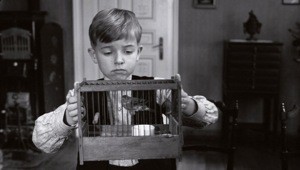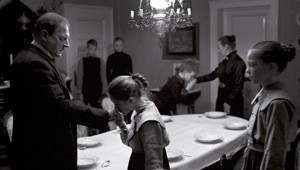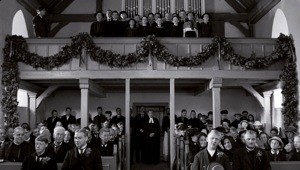A Children's Tale: The White Ribbon Turns Michael Haneke's Bleak Filmmaking Back On Itself
Unlike the other Oscar nominees for Best Foreign Film, Michael Haneke’s The White Ribbon takes place at a time that almost no one is old enough to remember directly. Set in a Prussian village, Eichwald, in the year leading up to the First World War, this beautiful and disturbing film transports us to a world in which modernity is more a rumor than a reality. Although the early twentieth century witnessed the rise of the automobile and aviation, the only transportation that Eichwald’s inhabitants have available to them are the bicycle and the horse-drawn carriage. And despite the fact that this period marked the heyday of the newspaper and the popularization of film as a means of entertainment, the village’s only forms of public expression are the decrees of the local nobleman, the sermons of the town’s Protestant minister, and simple word of mouth.
Given Haneke’s long-standing preoccupation with the anaesthetizing effects of mass media, highlighted in such pictures as Benny’s Video and Caché, his latest effort, which won the Palme d’Or at the Cannes Film Festival, marks a significant departure. Clearly, whatever troubles Eichwald has cannot be blamed on movies or television. But there is plenty of trouble regardless. The plot centers on a series of incidents at odds with the village’s appearance of rustic wholesomeness. The local doctor is seriously injured when a wire strung between two trees cuts down his horse. A peasant woman falls to her death when a rotten plank in the local mill gives way. The nobleman’s son disappears and then is found hanging upside down, badly beaten.
Contrasted with the “timeless” rituals of this agrarian community, these breaks with routine foreshadow the imminent destruction of its way of life. But they also suggest that Eichwald was built on unstable foundations, like that rotten plank, to begin with. The unrest that surfaces after the peasant woman’s death testifies to the exaggerated class divisions of the region, where most people are still in the thrall of a de facto serfdom and the national government is barely perceptible behind the late feudalism that seems to prevail locally.
Those familiar with the stories of Sholem Aleichem – and who, after Fiddler on the Roof, is not? – will recognize the parallels between Eichwald and the shtetl existence he depicted. Significantly, although the Prussian village initially appears cut off from the outside world, we do get a glimpse of migrant workers brought in to help with the baron’s harvest in 1913 and hear him discuss the need to quarter a large group of Poles the following summer. His holdings are too massive to have local peasants perform all of his labor. This is a world, in short, whose smallness is a function of the prevailing economic and political order rather than a natural condition. People take trains. But the villagers don’t see themselves as the sort of people who do.
Unlike Tevye the Milkman, however, Eichwald’s inhabitants do not seem to worry about intrusions from outside the village. Only rarely do we see a representation of state power independent of the baron. A single policeman gives a cursory investigation of the doctor’s riding accident. Others are said to ask questions about what happened to the baron’s son. But on only one occasion do we get the sense that authorities from outside the village have a real interest in what happens within it.
A daughter of the baron’s steward confesses to the schoolteacher that she has had a premonition: something bad will befall the village’s mentally challenged child. He reassures her that this vision is not grounded in reality. But when that poor boy turns up savagely beaten, he is forced to reconsider. In light of previous incidents, particularly what happened to the baron’s son, the schoolteacher decides that he cannot keep this information to himself. This impulse could be motivated by his own feelings of being an outsider in the village. Although he hails from a nearby village himself, the fact that he is educated and possibly of Jewish descent – his father is a tailor and his appearance deviates sharply from the pale natives – may make him regard external authorities in a more positive light.
Police detectives from the nearest town are called in to interview the girl. Instead of indulging her insistence that the vision came to her in a nightmare, the lead detective – who also strays from the village’s blond, blue-eyed standard - questions her very roughly. He is certain that she must have had knowledge of a plot against the boy. Particularly noteworthy, in light of The White Ribbon’s setting, is the dismissive attitude the detective projects towards the very idea of being warned by one’s unconscious. As the standard-bearer of modernity, he advocates a realism completely devoid of magic.
The question is whether Michael Haneke shares that point of view. In his previous films, the director made a point of accentuating the objectivity of the movie camera. He refused to let his audiences collapse the distinction between its dispassionate point of view and that of his characters, unless, as is the case with the youthful sadists Funny Games, those characters are like machines themselves. In The White Ribbon, though, he breaks with precedent and gives us a narrator: the schoolteacher. Although on the periphery of most of the narrative’s important events, he is still an active participant in the life of the village. He recounts the disturbing incidents in a retrospective voice-over, imparting a sense of humanity to the film that the impersonal narration of the camera eye could never provide.
In one of his greatest essays, “The Storyteller,” Walter Benjamin uses the work of the nineteenth-century Russian author Nikolai Leskov as the starting point for an examination of the relationship between narrative and modernity. “Every morning brings us the news of the globe,” he writes, “and yet we are poor in noteworthy stories. This is because no event any longer comes to us without already being shot through with explanation. In other words, by now almost nothing that happens benefits storytelling; almost everything benefits information.”
Like the sweeping statements Benjamin makes in his better-known “The Work of Art in the Age of Mechanical Reproduction,” his thesis here seems to capture our present-day circumstances even better than it did when he composed it. From Twitter to the comment pages on major news sites, ours is an era in which the volume of commentary has so far outstripped its ostensible object that finding the heart of a tale can feel like an impossible task. That’s part of the reason why so many novelists and filmmakers go out of their way to discuss their own works. They are desperate to direct commentary back to their artistic intentions.
But not only are such efforts likely to be in vain, they also miss the point that Benjamin so ably articulates in his essay: once the teller takes precedence over the tale, the essence of storytelling has already been lost. “Experience which is passed on from mouth to mouth,” he argues, “is the source from which all storytellers have drawn. And among those who have written down the tales, it is the great ones whose written version differs least from the speech of the many nameless storytellers.”
Reading these words, it’s impossible not to think of those collectors of fairy tales who roamed the European countryside in the eighteenth and nineteenth century. They knew they were in a race against time, as the increased speed and frequency of long-distance communication was inexorably reducing the degree of regional difference. To be sure, their own exertions contributed to the standardization of the very diversity that so intrigued them. Nevertheless, they succeeded in capturing tales in a simple language stamped with the imprimatur of a community rather than an individual.
Given Michael Haneke’s notoriety as a director of formally elegant films, it might seem odd to connect The White Ribbon to the legacy of the storyteller that Benjamin discusses. But there’s surely a reason why the film’s original German title isn’t just Das Weisse Band, but Das Weisse Band: Eine Deutsche Kindergeschichte. Many of the main characters are children, surely. However, the term Kindergeschichte doesn’t denote the subject matter of a story, but rather a literary classification. Like the Märchen of the Brothers Grimm, The White Ribbon is presented as a tale for children.
Since only completely uninformed or outright sadistic parents would take their children to see a Michael Haneke film – even teenagers might find his work too disturbing to bear – the real significance of the longer German title pertains to The White Ribbon’s genre. What makes the picture so compelling is the restraint it demonstrates. We are shown some things and told others. Yet the gaps in the narrative, both in terms of the camera’s narration and the schoolteacher’s retrospective voice-over, are too big to ignore. Simply put, The White Ribbon represents the rare contemporary narrative that is not “shot through with explanation.”
Haneke thereby manages to turn the extreme objectivity of his earlier films back on itself. But he does not do this in order to evoke nostalgia for a simpler time. The villagers of Eichwald are no better off than their equivalents in present-day subdivisions. And their lives are harder according to almost every quantifiable measure. The loss signaled by the arrival of World War I at the end of the narrative is not a loss of innocence, the passage from a “Golden Age” into its tarnished successor. If there is anything to mourn in Eichwald’s imminent transformation, it’s simply the disappearance of the capacity to tell this kind of tale without referring to broader geo-political forces. Or, to put that insight into terms Walter Benjamin would appreciate, what passes away is our capacity to perceive the tale as something other than an allegory, a premonition of horrors to come.
![[the current issue of ZEEK]](../../image/2/100/0/5/uploads/leftistethicistgraphic-52842c6a.png)
- 5000 Pages of Zeek
- Founded in 2001, Zeek was the first Jewish online magazine, and we have over 5000 pages online to prove it, all available free of charge. Read more in the Archive.
More articles by
Charlie Bertsch
More articles in
Arts and Culture
- Euphoria, Curiosity, Exile & the Ongoing Journey of a Hasidic Rebel: A Q & A with Shulem Deen
- Poet Q, Poet A: Jews Are Funny! Six Poets on Jewish Humor, Poetry & Activism and Survival
- Tackling Hate Speech With Textiles: Robin Atlas in New York for Tu B’Shvat
- Fiction: Angels Out of America
- When Is an Acceptance Speech Really a Speech About Acceptance?




